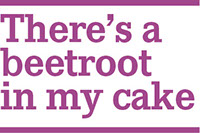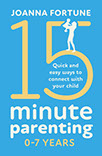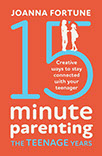
Food Play and Feeding Happiness
with Joanna Fortune
Child Psychology / Healthy Eating
Joanna Fortune, MICP, MIFPP, CTTTS, Reg Pract APPI, Ap Sup PTI, is a Clinical Psychotherapist and Attachment specialist. With over fifteen years experience working with children and families, she specializes in child and adolescent psychotherapy.

Parenting can be a bit of a minefield, both frustrating and exhausting, exhilarating and rewarding all at the same time. Along the way there are plenty of moments of uncertainty: Is my baby getting enough sleep? Is my toddler eating the right things? Am I spending enough time with my child? We’re sure you can rattle off many more examples!
Clinical Psychotherapist and parenting expert, Joanna Fortune, has recently published her book, ’15-Minute Parenting: The quick and easy way to connect with your child’, to help parents navigate their way through the difficult early years. In her book Joanna highlights the importance of connection in infancy, toddlerhood, and childhood, and shares her proven techniques that will help us to better understand our relationship with our children as they grow. Perfect for busy and time-poor mums and dads, we absolutely love Joanna’s formula of just fifteen minutes of mindful playtime each day. Simple and effective and an easy and enjoyable way to resolve many of our parenting frustrations. Joanna reminds us in her books that play is the language of children and their way of communicating with us.
By rediscovering the joy of play as an adult, we can understand and respond to our children in a whole new way. And we get to have fun doing it!
We are so excited to have Joanna answering a few of our questions about eating habits and how to have more enjoyable mealtimes. Joanna also shares her top tips on feeding fussy eaters, and more!
Jen: It can be pretty frustrating (read ‘extremely’!) when you’ve lovingly prepared a nice family meal which is met with a big fat ‘no’ from your child. In our experience with our children, even the most adventurous of eaters can go through fussier phases and others are just trickier from the get-go! What can you suggest to encourage really fussy eaters to explore new foods?
Joanna: My baseline when it comes to children and food is to remove emotional charge around it. Do not use food to incentivise behaviour or to respond to emotions i.e. never say, ‘If you eat this you can have ice-cream’ or, ‘Don’t cry, let’s have a chocolate bar to cheer up’. And it is always the sweet treats we use in this way - does anyone incentivise with broccoli?! I think not. So, we teach our children that there is a hierarchy to foods: the good and the bad.
I also think it is important to tune into how you are feeling. The food we prepare and present to our children is a way that we seek to nurture them and to then have that attempt to nurture rejected or met with disgust can be very triggering for us. Again, in most areas of parenting I like to pause and ask myself how I experienced mealtimes with my parents growing up. How did I wish it had been for me as a child? So, I would approach this with a gentle yet firm tone. No one gets their favourite meal every day but maybe it should be once a week.
In each meal, especially when you are presenting a new food, try to ensure there is something more familiar for your child that you know they will eat because if they start with that, at least they are engaged with the meal and may even try something else while they are sitting there and start eating. Consider the teaspoon taste as an approach. For this, everyone gets a teaspoon of something new on their plate (and not just the children) and everyone is invited to try it. Model tasting it yourself. If you child also tries it, praise their effort regardless of their reaction to it. If they do not try it, let it go but each day, ensure a teaspoon of something out of their comfort zone is there.
Jen: Most parents probably like the idea of sitting around the dining table together but busy schedules – kids’ after-school activities and long working hours – can get in the way. What advice would you give to parents who are time poor but would like to introduce more family mealtimes?
Joanna: Mealtimes are about more than food. They are an opportunity to connect and to socialise and experience the more social aspect of food beyond its nutritional value/role. Aim to sit together for one meal per day and ensure that this is a time to chat, laugh, and share.
Jen: Those family mealtimes where we all share food together, talking about our day with lots of laughs thrown in are some of our favourite moments but the reality is, especially as our kiddos are getting older, that it very often ends up with squabbling (suddenly the orange cup is the one that everyone NEEDS to have!) and exasperated parents who inhale the meal so we can move on to bedtime more quickly! How can we have mealtimes without stress and frustration? Do you have any tips on how to make it a time of day that the family looks forward to and enjoys?
Joanna: Structure this by saying that everyone takes a turn to share their favourite bit of their day and one thing they wish they could have changed. (If this is at the start of the day it can be one thing they anticipate positively and one thing they are unsure about.) This is not for you to fix and advise but to listen and acknowledge their emotional experience. Share your own too. Also, if they are older, consider playing a narrative activity such as popcorn story-telling whereby one of you starts a story (the kernel) and each of you takes a turn adding onto it so that it grows and expands. Keep it going for a couple of rounds and start over. I like to start with once upon a time because anything is possible in once upon a time and the story can be as wild and wacky as they like.
Jen: We have been brought up hearing ‘don’t play with your food’ but parenting has massively changed in the last decade and we are curious if this still applies today. Our children play lots of little games at the table - broccoli are our trees and we build a forest on our plates and spaghetti usually leads to the re-enactment of the Lady and the Tramp restaurant scene. We have always done it and like to keep the atmosphere at the table light and easy. Should we embrace this or are we encouraging ‘bad habits’?
Joanna: Well, I like to play with everything and to take as many opportunities as possible for playful engagement, grabbing those opportunities for shared joy wherever you can get them! So, I say yes…within boundaries. I like to do sensory bowls that involve foods such as a dry bowl with (uncooked) red/green lentils, lima beans (can be a choking hazard if you have smallies in the house) and the bow tie-shaped pasta or rice that I have dyed with food colouring.
I fill a bowl and might bury a small toy in there or a coin to rummage for. I like to give paper cups to pour the grains from one to the other. We bury hands and mush it all up…and even stick our feet in there too or, when (and that is when not if) it falls all over the floor, I say let’s dance on it with our bare feet. Also, when I am peeling my veggies I save the peelings in a bowl for my child to make food art with while I am cooking. This is great sensory play with food. I let my little one stir the pot or squish the dough so she gets familiar with the texture of different foods and the creative aspect of putting it together. BUT not at the table. At the table we try to keep food on our plate and we eat and chat and laugh and play in other ways. This is because you will want your child to behave and follow social norms when in a restaurant and it is very difficult for a child to hold two conflicting sets of rules about the same thing (eating at the table) in mind so try to keep it consistent in this regard. Having a variety of textures on the table to select from is playful without becoming a food fight type of play too.
Jen: Some of our readers will be about to embark on their weaning journey and looking forward to introducing their baby to the wonderful world of food; others have older children and are keen to improve their family’s eating habits. What tips can you give on how to feed children, no matter which age bracket they fall into (0-7, 8-12, and 13-18 years), in a way that creates a healthy relationship with food and generates an interest in healthy eating?
Joanna: Praise effort over outcome. Express curiosity and use prosody of voice as you do so. ‘OOH I wonder what this tastes like?’ A wrinkled face or change of tone to express, ‘Eugh, you did not like that one/mmmm you like this taste, yummy’. Play with textures and tastes and make sense of their experience for them. Trying is enough without the expectation that they like everything. Who does after all?
Chat and sing and use a positive affect about eating and food. If they reject it, make two to three good attempts to try it and then say, “Okay, you don’t want to eat this, mealtime is done. Let’s go play”, rather than running to get something else for them to eat each time. When they are hungry, generally speaking, they will eat.
Ensure lots and lots of sensory play at these ages to make new textures appealing. Allow adequate time to eat and try not to focus on things like mess in a negative way. Embrace the exploration and mess it brings as this means, ‘I am finding food and mealtimes fun and exciting’. As they grow, talk about how food helps our bodies do all we need to and to help us to grow strong and healthy. Talk about bodies in terms of what they can do rather than how they look and talk about how smart our bodies are to know and tell us when we are hungry/full. Avoid body-based nicknames (such as stretch, skinny malinky, buddha belly, pudge etc) as doing so places an emotional focus on how the body looks.
Jen: A couple of years ago my eldest daughter, then around 7 years’ old, went to a party which I didn’t stay for and, let’s just say, slightly overindulged at the party table and spent the night feeling very sick and sorry for herself. The silver lining is that she learned a tough lesson and now is much more in tune with her body and knows when to stop! How can we best teach our children to self-regulate when it comes to food, particularly those more ‘treat’ foods at parties etc? And particularly amongst the older age group when we aren’t necessarily there to help them with their food choices?
Joanna: Balance is key with a little of everything, ensuring that so-called treat foods are not so rare that your child will guzzle them when they get the rare chance to. It is better to say that they are called treat foods because a little is all our bodies can hold without feeling unwell. Repeat as above about how our bodies are smart and can tell us when we need to eat and when we have had enough. Avoid language that describes food in “clean” or “good/bad” terms. Food is just food.
We must teach our children to have fun with food, to experience it in its functional and social forms and to remove the emotional charge from food and eating. Model balanced, healthy attitudes towards all food types yourself because we parents are our children’s teachers in this and many other regards. That is the key to developing a self-regulating and mindful approach to eating.
For more information please visit:




© 2020 Beetroot in my Cake. Design by PACO Branding & Design. All rights reserved.
Use of this site constitutes acceptance of its User Agreement and Privacy Policy.